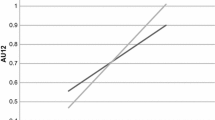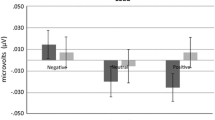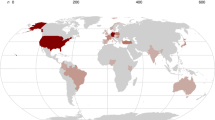Abstract
Subjects imagined situations during which they reported feeling happiness, sadness, anger, or fear, at both low and high levels of imagined sociality. Electromyographic (EMG) activity was recorded from four facial sites overlying the left forehead, brow, cheek, and lip. Controlling for reported emotion, facial EMG activity was influenced by the sociality of the imagery. Results corroborate previous findings of imaginary audience effects on smiling, and extend these effects to imagined situations that elicit dysphoria.
Similar content being viewed by others

References
Bainum, C.K., Lounsbury, K.R., & Pollio, H.R. (1984). The development of laughing and smiling in nursery school children.Child Development, 55 1946–1957.
Bavelas, J.B., Black, A., Lemery, C.R., & Mullett, J. (1986). “Ishow how you feel”: Motor mimicry as a communicative act.Journal of Personality and Social Psychology, 50 322–329.
Brightman, V.J., Segal, A.L., Werther, P., & Steiner, J. (1975). Ethologic study of facial expressions in response to taste stimuli.Journal of Dental Research, 54, L141 (Abstract).
Brightman, V.J., Segal, A.L., Werther, P., & Steiner, J. (1977). Facial expression and hedonic response to taste stimuli.Journal of Dental Research, 56, B161 (Abstract).
Buck, R. (1984).The communication of emotion. New York: Guilford.
Buck, R. (1991). Social factors in facial display and communication: A reply to Chovil and others.Journal of Nonverbal Behavior, 15 155–161.
Cacioppo, J.T., Tassinary, L.G., & Fridlund, A.J. (1990). The skeletomotor system: Surface electromyography. In J.T. Cacioppo, L.G. Tassinary, & R.E. Petty (Eds.),Principles of psychophysiology: Physical, social, and inferential elements (pp. 325–384). Cambridge: Cambridge University Press.
Chapman, A.J. (1973). Social facilitation of laughter in children.Journal of Experimental Social Psychology, 9 528–541.
Chapman, A.J. (1975). Humorous laughter in children.Journal of Personality and Social Psychology 31, 42–49.
Chapman, A.J., & Wright, D.S. (1976). Social enhancement of laughter: An experimental analysis of some companion variables.Journal of Experimental Child Psychology, 21 201–218.
Chapman, C.A., Chapman, L.J., & Lefebvre, L. (1990). Spider monkey alarm calls: Honest advertisement or warning kin?Animal Behaviour, 39 197–198.
Cheney, D.L., & Seyfarth, R.M. (1980). Vocal recognition in free-ranging vervet monkeys.Animal Behaviour, 28 362–367.
Cheney, D.L., & Seyfarth, R.M. (1982). Recognition of individuals within and between groups of free-ranging vervet monkeys.Animal Behaviour, 30 739–751.
Cheney, D.L., & Seyfarth, R.M. (1985). The social and nonsocial world of non-human primates. In R.A. Hinde, A. Perret-Clermont, & J. Stevenson-Hinde (Eds.),Social relationships and cognitive development (pp. 33–44). Oxford: Oxford University Press.
Chovil, N. (1991). Communicative functions of facial displays.Journal of Nonverbal Behavior, 15 141–154.
Chovil, N., & Fridlund, A.J. (1991). Why emotionality cannot equal sociality: Reply to Buck.Journal of Nonverbal Behavior, 15 163–167.
Cooley, C.H. (1902).Human nature and the social order. New York: Scribner's.
D'Amato, M.R. (1970).Experimental psychology: Methodology, psychophysics, and learning. New York: McGraw-Hill.
Darwin, C. (1872).Expression of the emotions in man and animals. London: Albemarle.
Ekman, P. (1979). About brows: Emotional and conversational signals. In J. Aschoff, M. von Cranach, K. Foppa, W. Lepenies, & D. Ploog (Eds.),Human ethology. Cambridge: Cambridge University Press.
Ekman, P. (1984). Expression and the nature of emotion. In P. Ekman & K. Scherer (Eds.),Approaches to emotion (pp. 319–343). Hillsdale, NJ: Erlbaum.
Ekman, P., Davidson, R.J., & Friesen, W.V. (1990). The Duchenne smile: Emotional expression and brain physiology II.Journal of Personality and Social Psychology, 58 342–353.
Ekman, P., & Fridlund, A.J. (1987). Assessment of facial behavior in affective disorders. In J.D. Maser (Ed.),Depression and expressive behavior. Hillsdale, NJ: Erlbaum.
Ekman, P., & Friesen, W.V. (1978).The facial action coding system. Palo Alto, CA: Consulting Psychologists Press.
Ekman, P., Friesen, W.V., & Ancoli, S. (1980).Journal of Personality and Social Psychology, 39 1125–1134.
Freedman, J.L., & Perlick, D. (1979). Crowding, contagion, and laughter.Journal of Experimental Social Psychology, 15 295–303.
Fridlund, A.J. (1979). Contour-following integrator for dynamic tracking of electromyographic data.Psychophysiology, 16 491–493.
Fridlund, A.J. (1988). What can asymmetry and laterality in facial EMG tell us about the face and brain?International Journal of Neuroscience, 39 53–69.
Fridlund, A.J. (1991a). Evolution and facial action in reflex, social motive, and paralanguage.Biological Psychology, 32 3–100.
Fridlund, A.J. (1991b). Sociality of solitary smiles: Effects of an implicit audience.Journal of Personality and Social Psychology, 60 229–240.
Fridlund, A.J. (1992a). Darwin's anti-darwinism and theExpression of the emotions in man and animals. In K.T. Strongman (Ed.),International Review of Emotion (Vol. 2). New York: Wiley.
Fridlund, A.J. (1992b). The behavioral ecology and sociality of human facial display.Review of Personality and Social Psychology, 13 90–121.
Fridlund, A.J., & Cacioppo, J.T. (1986). Guidelines for human electromyographic research.Psychophysiology, 23 567–589.
Fridlund, A.J., & Chovil, N. (1991). Why emotionality cannot equal sociality: Reply to Buck.Journal of Nonverbal Behavior, 15 163–167.
Fridlund, A.J., Ekman, P., & Oster, H. (1987). Facial expressions of emotion. In A.W. Siegman & S. Feldstein (Eds.),Nonverbal behavior and communication (2nd Ed.) (pp. 143–224). Hillsdale, NJ: Erlbaum.
Fridlund, A.J., & Fowler, S.C. (1978). An eight-channel computer-controlled scanning electromyograph.Behavior Research Methods & Instrumentation, 10 652–662.
Fridlund, A.J., Fowler, S.C., & Pritchard, D.A. (1980). Striate muscle tensional patterning in frontalis EMG biofeedback.Psychophysiology, 17 47–55.
Fridlund, A.J., & Gilbert, A.N. (1985). Emotions and facial expressions (Letter to the Editor).Science, 230 607–608.
Fridlund, A.J., & Izard, C.E. (1983). Electromyographic studies of facial expressions of emotions and patterns of emotions. In J.T. Cacioppo & R.E. Petty (Eds.),Social psychophysiology: A sourcebook (pp. 243–286). New York: Guilford.
Fridlund, A.J., Sabini, J.P., Hedlund, L.E., Schaut, J.A., Shenker, J.I., & Knauer, M.J. (1990). Social determinants of facial expressions during affective imagery: Displaying to the people in your head.Journal of Nonverbal Behavior, 14 113–137.
Fridlund, A.J., Schwartz, G.E., & Fowler, S.C. (1984). Pattern-recognition of self-reported emotional state from multiple-site facial EMG activity during affective imagery.Psychophysiology, 21 622–637.
Friesen, W.V. (1972).Cultural differences in facial expressions in a social situation: An experimental test of the concept of display rules. Unpublished doctoral dissertation, University of California, San Francisco. San Francisco: University of California Microfilm Archives.
Gilbert, A.N., Fridlund, A.J., & Sabini, J. (1987). Hedonic and social determinants of facial displays to odors.Chemical Senses, 12 355–363.
Gratiolet, P. (1865).De la physionomie et des mouvements d'expression. Paris: J. Hetzel.
Gyger, M., & Marler, P. (1988). Food calling in the domestic fowl,Gallus gallus: The role of external referents and deception.Animal Behaviour, 36 358–365.
Izard, C.E. (1972).Patterns of emotion: A new analysis of anxiety and depression. New York: Academic Press.
Izard, C.E. (1979).The maximally discriminative facial movement coding system. Newark, DE: Instructional Resources Center, University of Delaware.
Jasper, H.H. (1958). Report on the committee on methods of clinical examination in electroencephalography.Electroencephalography and Clinical Neurophysiology, 10 370–375.
Jones, S.S., & Raag, T. (1989). Smile production in older infants: The importance of a social recipient for the facial signal.Child Development, 60 811–818.
Jones, S.S., Collins, K., & Hong, H.-W. (1991). An audience effect on smile production in 10-month-old infants.Psychological Science, 2 45–49.
Karakashian, S.J., Gyger, M., & Marler, P. (1988). Audience effects on alarm calling in chickens (Gallus gallus).Journal of Comparative Psychology, 102 129–135.
Keddy Hector, A.C., Seyfarth, R.M., & Raleigh, M.R. (1989). Male parental care, female choice, and the effect of an audience in vervet monkeys.Animal Behaviour, 38 262–271.
Kelley, H.H. (1979).Personal relationships: Their structures and processes. Hillsdale, NJ: Erlbaum.
Kleck, R.E., Vaughan, R.C., Cartwright-Smith, J., Vaughan, K.B., Colby, C.Z., & Lanzetta, J.T. (1976). Effects of being observed on expressive, subjective, and physiological responses to painful stimuli.Journal of Personality and Social Psychology, 34 1211–1218.
Kraut, R.E. (1982). Social presence, facial feedback, and emotion.Journal of Personality and Social Psychology, 42 853–863.
Kraut, R.E., & Johnston, R.E. (1979). Social and emotional messages of smiling: An ethological approach.Journal of Personality and Social Psychology, 37 1539–1553.
Marler, P., Duffy, A., & Pickert, R. (1986a). Vocal communication in the domestic chicken: I. Does a sender communicate information about the quality of a food referent to a receiver?Animal Behaviour, 34, 188–193.
Marler, P., Duffy, A., & Pickert, R. (1986b). Vocal communication in the domestic chicken: II. Is a sender sensitive to the presence and nature of a receiver?Animal Behaviour, 34 194–198.
McGuigan, F.J. (1978).Cognitive psychophysiology: Principles of covert behavior. Englewood Cliffs, NJ: Prentice-Hall.
Moore, B.R., & Stuttard, S. (1979). Dr. Guthrie andFelix domesticus or: Tripping over the cat.Science, 205 1031–1033.
Piderit, T. (1886).Grundzüge der Mimik und physiognomik. Brunswick, Germany: F. Vieweg und Sohn.
Schwartz, G.E., Fair, P.L., Salt, P., Mandel, M.R., & Klerman, G.L. (1976). Facial muscle patterning to affective imagery in depressed and nondepressed subjects.Science, 192 489–491.
Sherman, P.W. (1977). Nepotism and the evolution of alarm calls.Science, 197 1246–1253.
Skinner, B.F. (1957).Verbal behavior. Englewood Cliffs, NJ: Prentice-Hall.
Stevens, S.S. (1956). The direct estimation of sensory magnitudes—loudness.American Journal of Psychology, 69 1–25.
Strong, P. (1970).Biophysical measurements. Beaverton, OR: Tektronix, Inc.
Yarczower, M., & Daruns, L. (1982). Social inhibition of spontaneous facial expressions in children.Journal of Personality and Social Psychology, 43 831–837.
Author information
Authors and Affiliations
Additional information
This research was supported in part by a University of California Academic Senate grant to the first author. We thank Norman Severe for his assistance in running subjects.
Rights and permissions
About this article
Cite this article
Fridlund, A.J., Kenworthy, K.G. & Jaffey, A.K. Audience effects in affective imagery: Replication and extension to dysphoric imagery. J Nonverbal Behav 16, 191–212 (1992). https://doi.org/10.1007/BF00988034
Issue Date:
DOI: https://doi.org/10.1007/BF00988034



